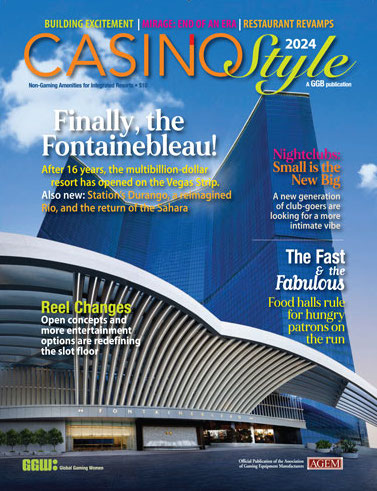
Las Vegas has a habit of reinventing itself. And 2023 demonstrated that Vegas is always changing, mostly for the better.
The change was most evident at the end of the year, when two spectacular new resorts opened: the Fontainebleau on the Las Vegas Strip, and Station Casinos’ Durango Resort Casino in suburban Las Vegas. When you add two innovative renovations that finalized in 2023—at the Rio and the Sahara—Las Vegas is turning the casino experience inside out yet again.
Miami Comes to Vegas
The opening of the Fontainebleau was clearly one of the most interesting debuts on the Strip in years. It took almost 20 years to bring the project to fruition.
A proposal was first announced in 2005, only a year from the worst U.S. recession since the 1970s. Nonetheless, construction began in 2007 and the structure reached its full 67 stories two years later. While it was—and still is—Nevada’s tallest occupiable building, the resort would not come alive for another 15 years.
In 2009, the property entered bankruptcy, and went through multiple owners and names until Jeffrey Soffer, the originator of the dream, reacquired it. In 2021, along with Koch Real Estate Investments, he reinstated the original name and construction resumed. When the Fontainebleau finally opened in December 2023, it seems the wait was well worth it.

Jeffrey Soffer
“For over 20 years I’ve had this vision of seeing the Fontainebleau brand on the Strip, and regaining ownership of the property allowed us to fulfill that vision,” Soffer told Global Gaming Business. “Fontainebleau Las Vegas is a beacon of our future and a testament to turning unexpected challenges into resounding triumphs.”
The Vegas property has an “irresistible, luxury allure reminiscent of Fontainebleau Miami Beach,” he says. “We wanted to reintroduce luxury into the city, meticulously crafted with precision and finesse, drawing inspiration from our heritage, and seizing every opportunity to be greater than we’ve ever been.”
Luxury is the theme in a city that’s seen everything, but the $3.7 billion Fontainebleau is the real thing. Originally designed by legendary casino architect Bergman Walls, it was completed by a team that is just as storied: an award-winning collaborative of architecture and design partners including Peter Arnell, David Collins Studio, the Rockwell Group, Lissoni & Partners, Lifescapes International, Jeff Leatham, Carlos Zapata Studio, Jeffrey Beers International, Westar Architects and others. The collective worked alongside the in-house team to complete Soffer’s vision for Fontainebleau Las Vegas.
Aiming High
The design approach is a homage to the iconic Fontainebleau Miami Beach, with a distinct and contemporary vision. Designers were mindful of what today’s travelers want to see and experience—modern flair and elegant details, creating a vibrant and compelling environment tailored to their desires.
Las Vegas has no ocean, so the Fontainebleau Las Vegas evokes that feel with a wide selection of pool experiences. The Oasis pool deck is six acres of water and cabanas. The adults-only LIV Beach is an all-night party, and La Mer is an exclusive pool that recalls the glamour of Hollywood. For VIP guests, the Legacy pool offers dedicated butler service and well-appointed cabanas.
The Lapis Spa & Wellness, designed by Lissoni & Partners, embodies a commitment to well-being, blending ancient rejuvenation methods with modern healing technologies for a transformative experience. Lapis is uniquely designed to adapt to guests’ natural circadian rhythms and biological clocks, so they can best achieve their individual goals.
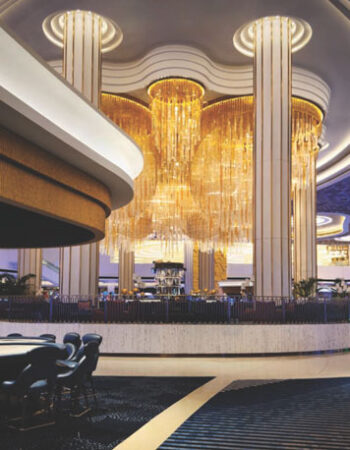
Like all Vegas casinos, Fontainebleau has stepped up its F&B with a lineup of 36 first-to-market restaurants and bars. Many of the F&B partners had prior relationships with Fontainebleau, but are coming to Las Vegas for the first time. Evan Funke, Masa Ito, David Grutman, David “Papi” Einhorn and Alan Yau highlight a diverse collection of chefs and restaurateurs.
The beverage program is helmed by Juyoung Kang, who’s led some of the best bar teams in the city. Her attention to detail, vast wealth of knowledge and endless creativity give each bar a signature style, from reimagined classics to one-of-a-kind cocktails.
Clearly, the Fontainebleau is aiming at the high-end luxury experience embodied by the best Strip resorts. The desire to achieve that level of service caused the Fontainebleau to poach executives from Wynn Resorts, including current CEO Maurice Wooden. As a result, Wynn filed a lawsuit demanding that Fontainebleau cease and desist from this activity.
But the luxury market is the cream at the top for the Fontainebleau, and the real business comes from the meetings and conventions, which Soffer believes will create solid and steady revenue.
Meeting Expectations
Fontainebleau Las Vegas has one of the largest convention and meeting spaces under one roof in the city, with more than half a million square feet of ballrooms and meeting rooms. The property is also directly adjacent to the Las Vegas Convention Center West Hall, which opened two years ago.
That proximity “creates synergistic opportunities unlike any other resort in Las Vegas,” says Soffer. “Our South Lobby acts as a destination for meeting professionals and convention-goers to enter the resort with ease.
“With a focus on upward-thinking design, seamless access and a dedicated sales team, our resort ensures a smooth transition from business to pleasure, while allowing for innovation in both accessibility and experiences. We recognize the crossover between business and leisure travelers, and look to accommodate both with our world-class meetings and convention amenities, along with our collection of incredible restaurants, bars, gaming, wellness and entertainment options.”
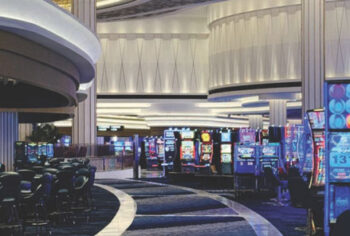
The convention industry is critically important to Las Vegas, and the meetings and convention facilities are a standout feature of Fontainebleau Las Vegas.
“We’ve built an unmatched canvas for tailored events, with versatility as a key theme,” Soffer says. “We have multi-functional spaces designed with intention, as well as indoor and outdoor options like our Waterbleau Terrace and Moonstone Event Center.”
Like many casinos that open with a limited database, Fontainebleau struggled out of the gate. But the future is bright, according to Soffer, who points to successful events like the Formula 1 race and last year’s Super Bowl. For him, Fontainebleau aligns perfectly with the legacy of Las Vegas.
“Las Vegas is always reinventing itself,” he says. “Those events are proof that the city is growing its global audience with visitors who are interested in experiences at the highest levels of hospitality.
“Enter Fontainebleau Las Vegas. Everything that stands out about our resort—iconic design, top-tier services, innovative offerings—will aim to contribute to the city’s ongoing transformation. We’re looking to set a new bar so that history remembers two eras: before Fontainebleau Las Vegas, and after.”
Local Challenge
Durango Casino Resort is Station Casinos’ first new property since Red Rock in 2006. Located on a tract in one of the fastest-growing areas in the valley, it offered a prime opportunity for the locals giant, says Station Chief Operating Officer Scott Kreeger: “The demographics are off the charts, and there’s really no competition within a five-mile radius. From a business perspective, it was a great opportunity for us.”
In December 2023, Durango opened to rave reviews.

Scott Kreeger
“From a customer feedback perspective, we’re overjoyed,” Kreeger says. “We always try to do something unique and different, property to property. We take the best parts of what we learned from the last property—in this case, Red Rock—then kind of grow on that.”
Station broke every rule with Durango. Instead of a dark cavernous space, it is open to daylight, streaming in through floor-to-ceiling windows. Gone are the rows of endless slots, replaced by mini-carousels of three to five machines. But the most dramatic change is in the sportsbook.
“Sports has been a huge piece of local gaming for years, and continues to be, but it’s morphed over time,” observes Kreeger. “Once on NFL Sundays, you had to be there before 10 o’clock to lay down your bets. Now you can do it with your phone. That’s changed what we’ve done. We’re the market-share leader in mobile sports wagers in the city, and we’re proud of that.”
He thanks “an incredible team. Art Manteris, who worked for us for years and is a legend in sports wagering, trained up some young guys that are the best in the business.”
 The race and sportsbook at Durango “will be the new model going forward. There’s a small over-the-counter area where you can get a ticket and bet on the games. We have large-format screens, great seating areas, an incredible bar where you can play video poker or watch a game and have a beer, and a really compelling food-and-beverage and entertainment component. The George (Sportsmen’s Lounge) does more than 2,000 covers on a Sunday. On Friday and Saturday nights, we have a country band or a different type of entertainment. So it’s really seven days a week and it’s been a smash.”
The race and sportsbook at Durango “will be the new model going forward. There’s a small over-the-counter area where you can get a ticket and bet on the games. We have large-format screens, great seating areas, an incredible bar where you can play video poker or watch a game and have a beer, and a really compelling food-and-beverage and entertainment component. The George (Sportsmen’s Lounge) does more than 2,000 covers on a Sunday. On Friday and Saturday nights, we have a country band or a different type of entertainment. So it’s really seven days a week and it’s been a smash.”
F&B at Durango also signals a shift in the Station strategy. “What we’re finding is that the more we lean into non-gaming amenities, (the more) Las Vegas grows up as a city,” Kreeger says. “We all used to go to the Strip when we went out to eat, but now the restaurant scene in the suburbs is quite dynamic. We think we’re driving some of that.”
Today, the company that once had to convince restaurants to operate at its casinos is fielding proposals from the nation’s top restaurateurs.
“Durango’s a testament to that,” says Kreeger. “James Beard Award-winning chefs and restaurant companies with over 150 units across the country are all interested in coming to our new developments. They’re doing food better than we ever could. And the customers agree.”
Rio Revival
When the Rio opened at its slightly off-Strip location in 1990, it was a resounding success. Designed, built and owned by Tony Marnell and his family, it was the place to see and be seen. But in 1999, when it was bought by Caesars Entertainment, its main claim to fame was as home of the World Series of Poker. Caesars never reinvested in the property, and its decline was sad to see.
 Enter Dreamscape and Eric Birnbaum.
Enter Dreamscape and Eric Birnbaum.
In 2019, Birnbaum bought the property for $516 million, and though Caesars continued to run it for two years with the Caesars Rewards program—again, it did so without reinvestment. Finally, Dreamscape put together a management team, invested another $350 million, and hired industry veteran Patrick Miller as CEO. Kevin Sweet, chief gaming executive, says Miller’s experience is a big plus for the Rio.
“He was in charge of Monte Carlo when they rebranded it as Park MGM, a very similar experience to what we’re going through at the Rio,” says Sweet. “I couldn’t be more excited about the energy and the ideas he’s bringing to the table.”
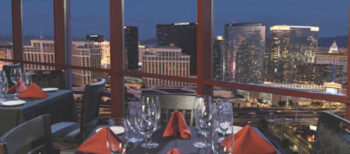 Dreamscape has big plans for the Rio, made evident by the nightly light show on the buildings that has become an attraction unto itself.
Dreamscape has big plans for the Rio, made evident by the nightly light show on the buildings that has become an attraction unto itself.
“It’s tough to put an ROI on lights on the building,” Sweet says, “but judging by the texts that I get and all the executives get—‘Your lights look so cool, the display is awesome’—it’s increasing the awareness of Rio. It’s been really beneficial and positive.”
Birnbaum hired Marnell Architecture, the firm that built the original Rio—a brilliant decision, says Sweet.
“They know every inch of this property. They know every nut and bolt, every run of a wire. They know what needs to be done. It’s been an amazing collaboration.”
The company has completely renovated the hotel rooms and suites, some of the largest in the city, to draw profitable gamblers.
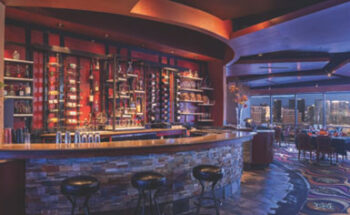 “We’re touching every aspect of this property,” Sweet says. “All 1,500 rooms are completely renovated. And remember, the Rio was the first all-suite hotel. The smallest room in the building is 580 square feet. It’s really a nice amenity for us, with floor-to-ceiling windows.”
“We’re touching every aspect of this property,” Sweet says. “All 1,500 rooms are completely renovated. And remember, the Rio was the first all-suite hotel. The smallest room in the building is 580 square feet. It’s really a nice amenity for us, with floor-to-ceiling windows.”
The Rio is also plugged into the Hyatt system, which is very helpful.
“Obviously we get to plug into the worldwide Hyatt database with the leisure customer booking and using their points,” says Sweet. “We’re also getting plugged into their group sales and convention sales pipeline, so we’re super-excited about that partnership.”
Although the legendary Rio buffet is gone, it’s been replaced by a food hall that includes a ramen shop, sushi, burgers, burritos and Tony Luke’s, the first West Coast outlet for the legendary Philly cheesesteak shop.
The signature nightclub of the year was the VooDoo Lounge on top of the Rio, now closed, with its million-dollar view of the Strip. Plans are under way for a new concept, but Sweet says the adjacent VooDoo Steakhouse will be on the “must-see” lists of Vegas visitors.
“Everything is affordably priced,” he says. “It’s exactly what we need—our first ‘Welcome to the new Rio’ statement. We’re a hybrid local-non-local property. Locals don’t care that I have 1,500 renovated rooms. But they like to have affordable dining options and easy free parking.
“We’re not playing in the luxury sandbox that all the new Vegas casinos are competing for,” Sweet adds. “I don’t believe anyone will ever build a middle-market Vegas property again, so if we can make this the destination for that three- to four-star market, that’s what we’re striving for. And that’s what we’re going to accomplish.”
Bringing Back the Brand
Few resorts in Las Vegas are as iconic as the Sahara Hotel. As one of the first resorts to open on the Strip during the 1950s, the Sahara had an African theme and included several additions designed by legendary Vegas architect Martin Stern Jr.
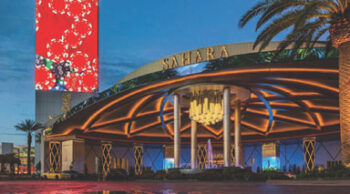 The hotel was home to many of the top entertainers of its day, and ownership over the years included big shots like Paul Lowden and Bill Bennett.
The hotel was home to many of the top entertainers of its day, and ownership over the years included big shots like Paul Lowden and Bill Bennett.
In 2007, the property was bought by Sam Nazarian’s SBE Entertainment Group, and converted into an SLS hotel, part of the hotel chain owned by SBE. But an ill-fated design and Nazarian’s licensing problems doomed the effort, and Alex Meruelo, owner of the Grand Sierra Resort in Reno, bought the property in 2018. Meruelo immediately started restoring the Sahara brand.
Nancy Paolino, principal with Innovativo Design Inc., has worked for more than 15 years helping Meruelo design his hotel properties. She says SLS “did not have the synergy that would encourage casino players to play and stay, quite frankly.
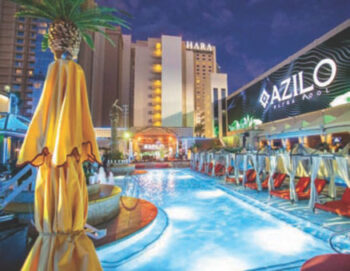 “We wanted the Sahara to be synonymous with the boutique look fitting with the property scale. And Mr. Meruelo likes things that are reflective of his style and personality.”
“We wanted the Sahara to be synonymous with the boutique look fitting with the property scale. And Mr. Meruelo likes things that are reflective of his style and personality.”
In rebranding back to the Sahara, Paolino says, “It was really important to us to honor the Sahara’s history. It was one of the most significant and initial platforms for entertainment in Las Vegas, before anyone else.”
Throughout the property today, there are images of those days, helping visitors recall the excitement and glamor of the original Sahara.
“In every single project at the property, there’s some nuance that reflects back to the old Sahara,” says Paolino, which she describes as “timeless elegance.”
Almost everything at the Sahara has changed since the SLS incarnation, but one thing that remains is Jose Andres Bazaar Meats, arguably the best steakhouse in Las Vegas.
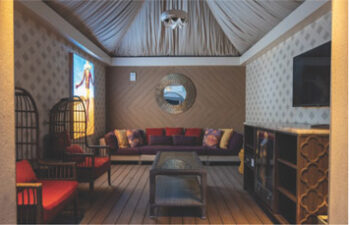 “We’ve maintained a very good relationship with Jose Andres,” says Paolino. “When we took over, he indicated a desire to stay at the property. We had the same desire and have a great partnership with him. It’s great for him and great for the Sahara.”
“We’ve maintained a very good relationship with Jose Andres,” says Paolino. “When we took over, he indicated a desire to stay at the property. We had the same desire and have a great partnership with him. It’s great for him and great for the Sahara.”
The new Sahara is also open to the Strip, “not an easy feat,” says Paolino. “We wanted it to feel like you’re driving into an oasis. So we developed a porte-cochere that feels like the old dome at the Sahara, but much more elegant and upscale, with a water feature along with lush landscaping.”
Pools have always been a signature of the Sahara. Today’s Azilo Ultra Pool blends a lavish outdoor poolscape with an indoor lounge to keep guests entertained day and night, complete with a 240-foot video screen.
Renovated rooms and suites “are certainly a reflection of the Meruelo level of design,” says Paolino. “Sure, I’m the idea-maker, but after 15 years, I know the level of taste and sophistication that this owner wants. In addition to the spacious rooms, the Alexandria Tower features a fun and inviting rooftop pool with close access to Amina Spa and the fitness center.”
Paolino says she stayed true to the design concept for the Sahara.
“We try to keep a flow within the property so every space complements every other. Whether it’s the room product or the amenities, the restaurants, shows or even the restrooms, we want guests to feel like we took an extra amount of time.”





